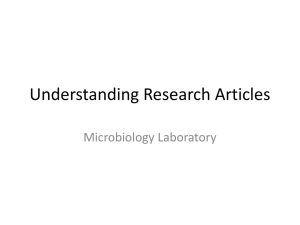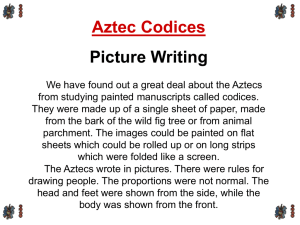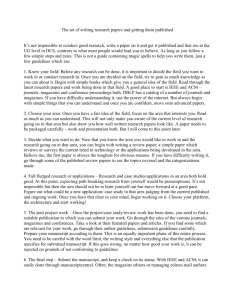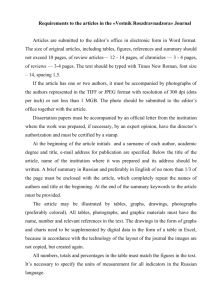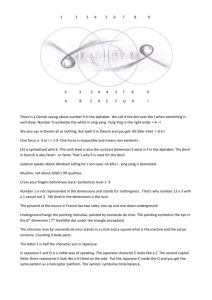ACRL-LA Workshop on Open Access - University of Louisiana at
advertisement
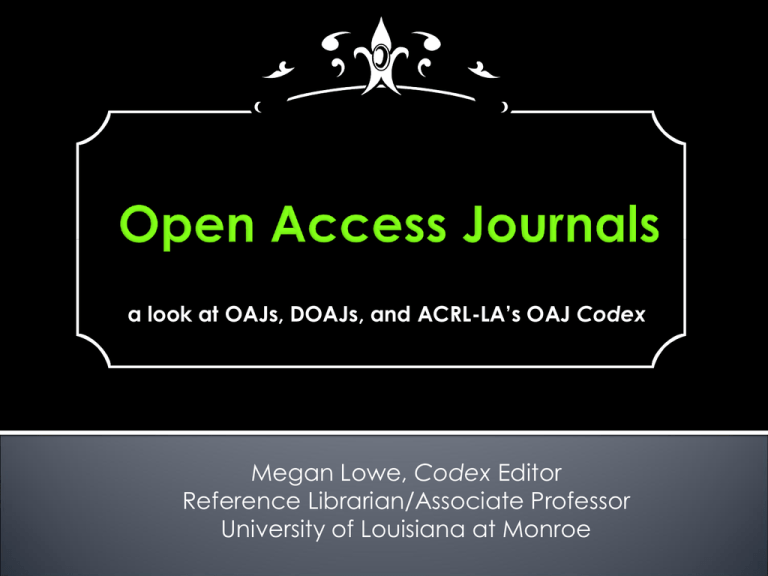
a look at OAJs, DOAJs, and ACRL-LA’s OAJ Codex
Megan Lowe, Codex Editor
Reference Librarian/Associate Professor
University of Louisiana at Monroe
I first came into contact with open access
journals (also called OAJs) in 2009, when
ACRL-LA was selected as one of five sites to
host the ACRL Scholarly Communication
101 Road Show
The program, “Scholarly Communication
101: Starting with Basics,” addressed several
issues of growing interest to libraries, with
hands-on applications and activities
The workshop, held in Baton Rouge, covered:
new methods of scholarly publishing and
communication
copyright and intellectual property
economics
open access and openness as a principle
These issues are inter-related in profound ways
that can impact libraries in positive ways.
Open access publishing functions as a
response to all of these issues
OAJs represent a new method of
scholarly publishing and communication
Before open access publishing, authors
published primarily in journals, which often
meant that authors surrendered their
copyrights of their work to the journal
This meant that though an author may
have done the actual work and writing
to produce an article, they did not retain
the rights to publish it again anywhere
else, even on their own web space
It also meant that an author’s work was
reaching a limited audience – an
audience that could afford access to
that journal
With the advent of OAJs, an author
could
retain most of their rights to their own work;
with most OAJs, authors surrender “first rights”
only – that is, authors grant the publisher the
right to be the first publication to publish the
material once
▪ In North America, this is called First North American
Serial Rights, or FNASR
▪ authors can republish that article anywhere else, as
long as they acknowledge the publication that first
published the article
and because most OAJs are freely available,
an author’s work can reach a much wider
audience
OAJs also represent a movement towards
protecting the copyrights and intellectual
property of authors
Most OAJs use Creative Commons licenses to
protect both their interests and the interests of
their authors
Creative Commons (CC) licenses allow
authors of original works certain rights, even
after publication
To copy, distribute, and transmit the work
To adapt the work
Traditional publishers often retained all rights
of an author’s work; CC gives those rights
back to the author
OAJs also make good money sense, too:
most OAJs DO NOT CHARGE for access –
there are no pricey subscriptions!
Traditional publishing means that the
publishers make BIG BUCKS from
subscriptions…
…while libraries often struggle to provide
access (budget cuts, anyone?) due to
the prohibitive costs of journals and
databases
And to add insult to injury: even when
libraries can get access, they aren’t
guaranteed FULL access – publishers
can impose embargoes and pull titles
without notice
The only money that is often
exchanged with regard to OAJs
usually comes from authors: some
OAJs charge authors publication fees
Most people assume that everything
on the Internet is free, and that what
they find there is quality, but as
librarians, we know better…
But the concept of freely available,
quality information is thrilling – how
better to encourage scholars than by
removing restrictions to research?
Locking away information in pricey
databases and restricting access limit
researchers’ ability to produce timely,
relevant, thorough work
Openness means eliminating or
diminishing those restrictions, allowing
researchers to focus on their research,
rather than struggling to obtain access
to materials
There are two types of open access (OA)
publishing, green and gold
Green OA means that authors can publish
in any journal (not necessarily an OAJ)
and then self-archive – that is, post their
postprint work other places, such as
institutional repositories or on their own
website
Gold OA is actual electronic
publication – an article is published in
an OAJ
In Gold OA there varying degrees of
access – most OAJs make their
content completely available, without
restrictions; others require the user to
create an account (usually free)
before granting them access
There are some Gold OA models that do
require some money to exchange hands;
that money is often a publication fee,
sometimes paid by the author of an article, or
a sponsor, like an academic institution
In those models, the author isn’t simply paying
to publish; the author’s work must be peerreviewed and accepted, then the fee is
charged – a lot of OAJs will waive these fees
in the case of economic hardship
The green and gold distinctions apply
primarily to the media in which the
content appears
Green applies to venues in which no
actual publishing occurs, like repositories
Gold applies to venues in which publishing
occurs, like OAJs – gold most often
includes peer-review, which green would
not
Gratis OA, in the words of Peter Suber
(who has written extensively on OA), is
OA that removes price barriers – that is, it
is free in the sense that it costs nothing
Libre OA – again, in the words of Peter
Suber – is OA that removes price barriers
and some permission barriers - this
primarily refers to restrictions (like
copyright)
The gratis vs. libre aspect of OA is
about user freedoms and rights, and
access
“In short,” according to Suber, “gratis
OA alone allows no uses beyond fair
use, and libre OA allows one or more
uses beyond fair use”
The Directory of Open Access Journals
(DOAJ) describes itself as being “a one stop
shop for users to Open Access Journals”
It is a “service [covering] free, full text, quality
controlled scientific and scholarly journals”
Its definition of OAJs are “journals that use a
funding model that does not charge readers
or their institutions for access”
OAJs must be quality controlled (peerreviewed), research-oriented periodicals
(must have an ISSN) in order to be included in
the DOAJ, and it aims to cover “all subjects
and all languages” (and it’s doing a pretty
good job of that)
Currently, it boasts 6271 journals, with 2721
of those being searchable at the article
level; as of March 15, 2011, there are
534,261articles in the directory
Additional criteria for inclusion into the DOAJ
All content must be freely available
If a journal requires registration, it must be free and online
(this is often done in order to track user statistics and allow
users to make comments)
No embargoes are allowed
Most OAJs in the Directory utilize CC licenses
OAJs must also allow users to “read, download,
copy, distribute, print, search, or link to the full texts
of these articles" (which would be libre)
The idea for the Directory first emerged in 2002 at
the First Nordic Conference on Scholarly
Communication in Lund/Copenhagen; during
the discussion about the idea, it was determined
that such a resource would be invaluable for
“the global research and education community”
Initial work on the Directory was supported by
the Open Society Institute (OSI)
OSI’s motto is “building vibrant and
tolerant democracies”
Currently, the minds behind the DOAJ are working
on long-term preservation of OAJs, in conjunction
with the e-Depot of the National Library of the
Netherlands and the Swedish Library Association
Their goal is to ensure “long-time access to digital
objects which would otherwise be threatened by
rapidly evolving software and hardware platforms
as well as media decay”
In 2010, Nicholls State University and the University
of Louisiana at Monroe partnered to determine a
way to cull the data available on the DOAJ so
DOAJ titles could essentially be cataloged and
included in LOUIS libraries’ catalogs
Happily, Nicholls’ own Jeremy Landry was able to
develop just such a program. ULM’s Chuck Hughes
tested it, and now DOAJ titles are included in LOUIS
holdings!
After attending the ACRL Road Show in 2009, I
got fired up about open access and OAJs
Mike Matthews, who was President of ACRL-LA
at the time, and I discussed the viability of
starting our very own OAJ, which would focus
on academic librarianship in Louisiana
We realized that such a publication would
benefit from having an organization behind it,
and our choice was clear: ACRL-LA!
With regard to copyright, Codex requires
authors to agree to a Creative Commons
Attribution License
This gives Codex first publication rights (FNASR),
while allowing authors to retain the rest of the
copyrights to their work
This means others can share the work as long
as the author, as well as the work’s initial
publication in Codex, are acknowledged
Codex is a gold OA that is essentially libre
It encourages green OA as well
It utilizes Open Journal Systems, an opensource “journal management and publishing
system,” developed by the Public
Knowledge Project, that is also supports
the principles of open access
It is peer-reviewed – Codex currently has about 40
peer reviewers that review articles
We also have our very own ISSN!
Currently, Codex is not in the DOAJ, but we’ve
submitted an application to be added
We will, however, be included in Ebscohost, like
several other OAJs, and we’re listed in Oxbridge
Communications’ Standard Periodical Directory
Speaking of Ebscohost – when Codex was
first contacted by Ebscohost about being
included in its products, there was some
concern about protecting the rights of the
journal and the authors, despite the
excitement of being associated with a big
name publisher and reaching a wider
audience. They sent us a contract…
…which was dutifully reviewed by several
members of ACRL-LA.
It was determined that the language of the
contract put the rights of the journal and the
authors in danger. This was unacceptable,
and we rejected Ebscohost’s offer with an
explanation regarding our concerns.
Ebscohost contacted us again some
months later, at which time I reiterated the
concerns regarding the journal’s rights and
the authors’ rights.
This time I was assured that a new contract
would be drawn up which would address
these issues and guarantee that Codex’s
copyright policies would be maintained,
and everybody’s rights protected.
Sure enough, a new contract was sent, and
again it was reviewed by several members of
ACRL-LA.
This time, the contract was deemed acceptable.
The language had been changed to guarantee
that everybody’s interests would be protected.
There have been two other cases of note
with regard to copyright issues for Codex.
One involved Josh Finnell, whom some of
you may know, and who has granted
permission for me to share this.
Josh submitted an article for publication in
the third issue of the journal. It had already
gone through peer review and was going to
be accepted for publication.
Before I could notify Josh that his article was
going to be accepted, he emailed me and
regretfully withdrew his article for consideration,
telling me the article had already been
published, which meant it could not be
published in Codex. (FNAR, remember?)
He told me that the article in question had
been submitted to another journal a year prior
to its submission to Codex.
However, he’d never heard a thing, so he
assumed the article had been rejected. Then, in
January 2011, a year after he’d submitted the
article to this other journal, the editor of the
journal suddenly emailed him and told him the
article was going to be published in the issue
that was about to come out.
This was frustrating, of course, for both of us, and
he shared that he’d other experiences where he
felt his rights had been infringed.
“One of the first articles I ever wrote was just
published two months ago in [title of journal
redacted]. Odd, since I wrote this article in
2007. I have a list of correspondence with
the editor about when I would receive
feedback about my submission (nothing for
two years!). I sent an email rescinding my
submission and published it in NMRT
Footnotes just to get it off my place.”
{continue}
“What should appear two months ago timestamped as 2008!??? Both are such minor
publications, and arguably one is a newsletter,
so I let the matter go.”
Clearly, Josh’s rights were not protected, or
even respected, in this case. It’s worth noting
that the second journal with which Josh had
issues has freely accessible content on its site,
as well as NMRT Footnotes (an ALA
publication!).
The other case concerned Benjamin Keele,
a library science graduate student who
submitted an article on DOIs in law journals.
His article was subsequently rejected
because the peer reviewers determined
that it was beyond the scope of Codex, but
before their reviews came in, two events
took place that demonstrated the benefits
of open access. Ben agreed to let me share
his story with you as well.
The first was that Ben told me that preprint
(essentially, a draft) of the article had already
been posted on the Social Science Research
Network (SSRN), and he was concerned that this
might conflict with Codex’s non-competitive
policy.
However, since what he posted was a preprint, it
was determined that this was acceptable. SSRN is
both a green OA and gold OA, as it publishes
through its own journals and partner journals.
The other issue concerned Ben’s being
named a winner in the American
Association of Law Libraries/LexisNexis Call
for Papers Competition (Student Division)
with the DOIs article. Winning meant the
article would be published in the Law Library
Journal. This caused some concern (again),
considering that LLJ is a traditional journal,
not OA.
However, Ben discussed the matter with
the editor of LLJ. LLJ was NOT going to ask
for the rights like most traditional journals; it
was actually going to grant him a CC
license.
This meant, since Codex was going to
“press” first, that it would receive FNASR
rights, and Ben could still publish it in LLJ.
Ultimately, open access is about two things:
1.
2.
Providing free access to scholarly research to
anybody with as few restrictions as possible
Protecting the rights of the authors, the publications,
and the users as well
Open access is still developing and changing,
but it’s gained a lot of ground, and scholars
and librarians are still working towards
spreading the principles of OA
Budapest Open Access Initiative. (2011, February
13). Budapest Open Access Initiative: Frequently
asked questions. Retrieved from
http://www.earlham.edu/~peters/fos/boaifaq.html
Creative Commons. (n.d.). Licenses. Retrieved from
http://www.creativecommons.org/licences/
DOAJ – Directory of Open Access Journals. (2011).
Directory of open access journals. Retrieved from
http://www.doaj.org
Gilks, M. (2000). Rights: What they mean and why
they’re important. Retrieved from
http://www.writing-world.com/rights/rights.shtml
Open Society Foundations. (2011).
Initiatives. Retrieved from
http://www.soros.org/initiatives
Public Knowledge Project. (n.d.) Open
journal systems. Retrieved from
http://www.pkp.sfu.ca/?q=ojs
Suber, P. (n.d.). Peter Suber. Retrieved from
http:///www.earlham.edu/~peters/hometoc.htm
Presentation URL
http://www.ulm.edu/~lowe/openaccesslla2011.ppt
Codex Homepage
http://codex.acrlla.org
ACRL-LA Homepage
http://www.acrlla.org
My Contact Info
lowe@ulm.edu
http://www.ulm.edu/~lowe
If you have questions, don’t hesitate to contact me!
Megan Lowe, Codex Editor
Reference Librarian/Associate Professor
University of Louisiana at Monroe

